BUS101 Business Analytics Report: Job Stress Analysis at Amazon
VerifiedAdded on 2023/03/31
|14
|2473
|156
Report
AI Summary
This report provides a qualitative business analysis of job stress at Amazon, addressing a critical business problem. The report begins with an introduction to the issue and provides a literature review, exploring the concept of stress, the Job Demand Resource (JD-R) model, its utility, and criticisms. The report presents managerial statements, research questions, and objectives. The methodology section details the use of qualitative analysis and semi-structured interviews with Amazon employees to gather insights. The findings section presents the results of the interviews, including employee responses to questions about job satisfaction and challenges faced. The analysis of interview data is provided, followed by recommendations for improving employee well-being, such as promoting workplace wellness, implementing leadership and managerial approaches, and offering more benefits. The report concludes by emphasizing the importance of addressing employee job stress for the overall health of the organization. The report is based on the assignment brief which requires a qualitative business report on solving a business problem of Job stress in Amazon, using theoretical framework to provide potential explanations for the issue. Further recommendations are provided depending on the findings of the report.
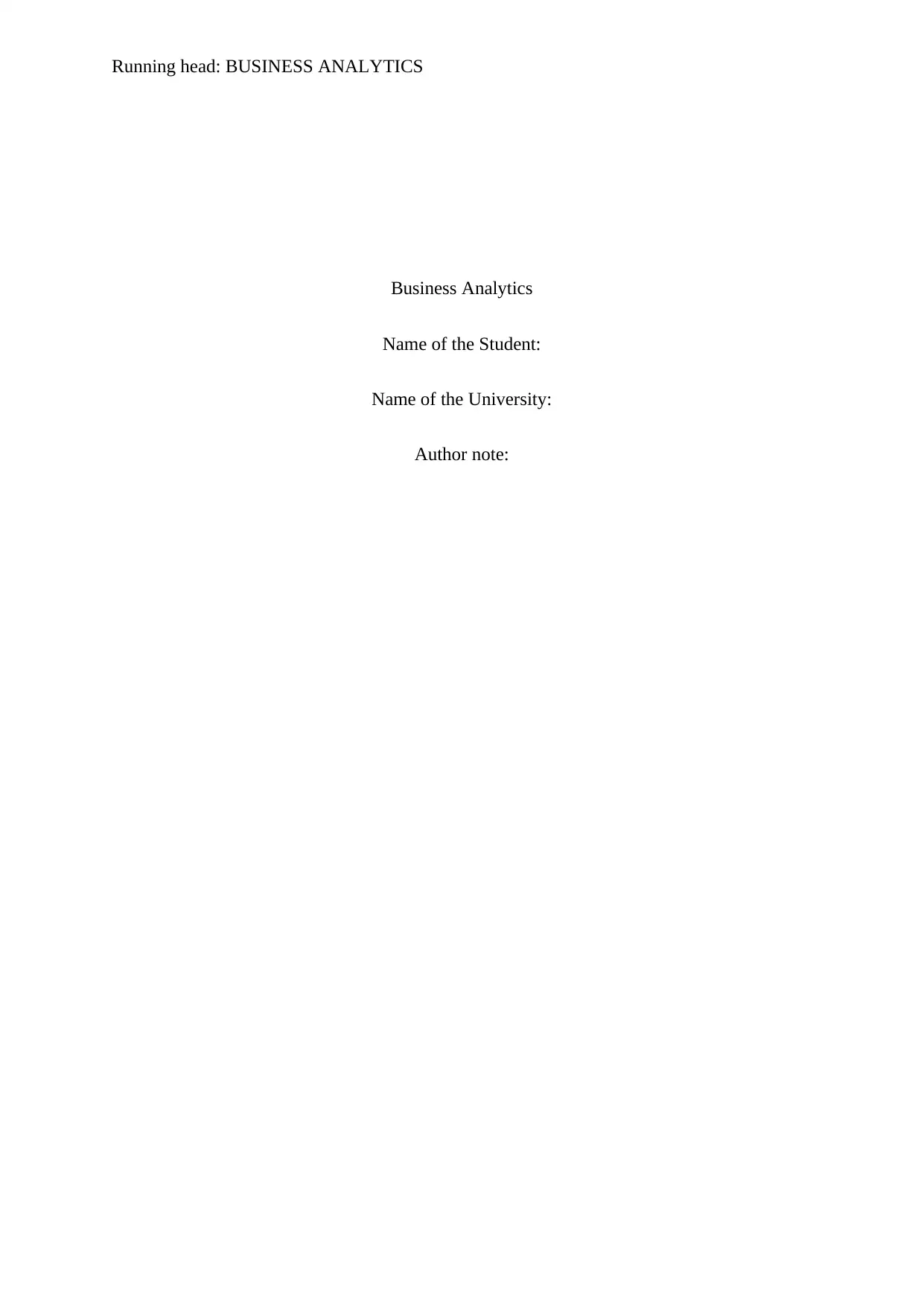
Running head: BUSINESS ANALYTICS
Business Analytics
Name of the Student:
Name of the University:
Author note:
Business Analytics
Name of the Student:
Name of the University:
Author note:
Paraphrase This Document
Need a fresh take? Get an instant paraphrase of this document with our AI Paraphraser
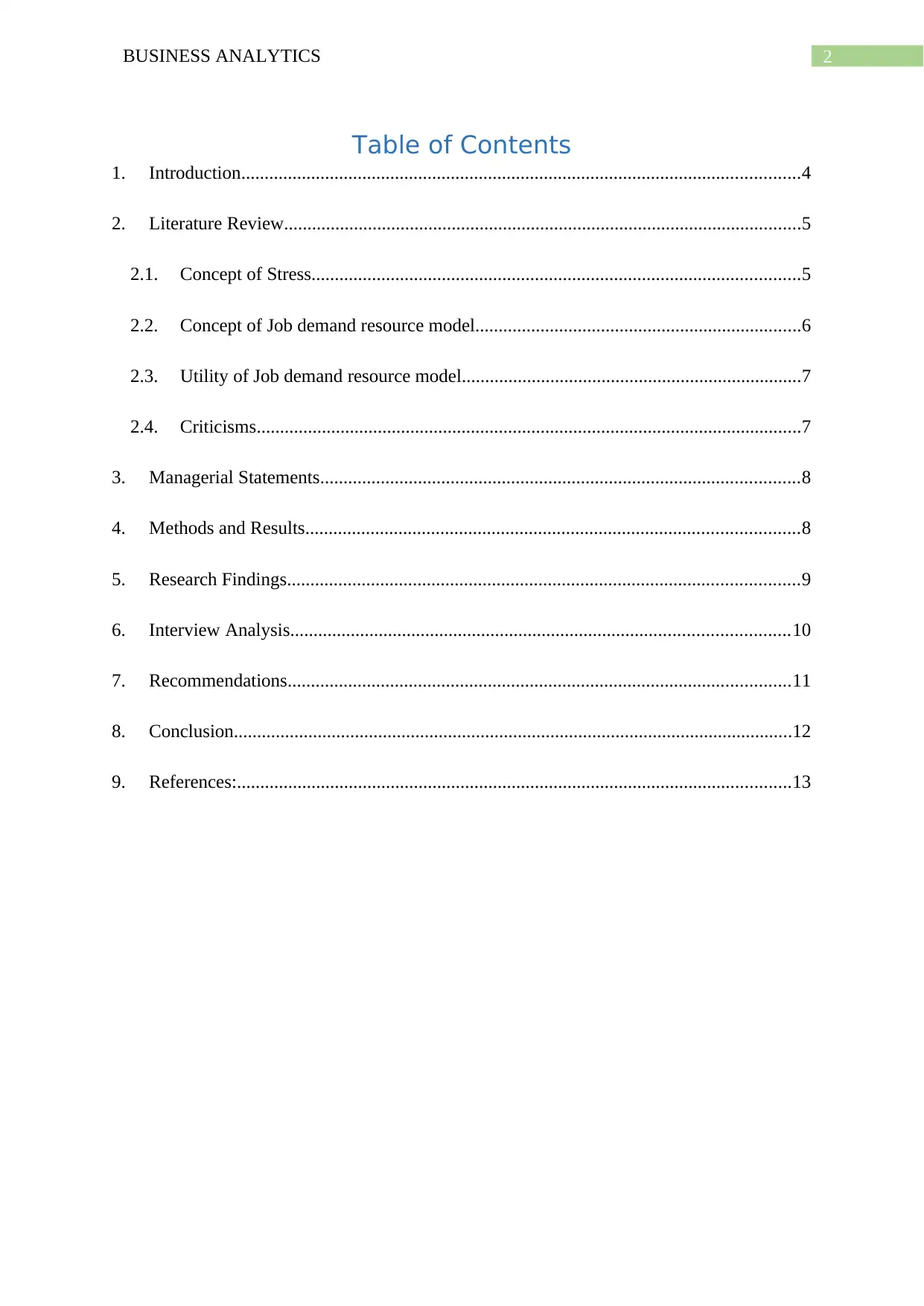
2BUSINESS ANALYTICS
Table of Contents
1. Introduction........................................................................................................................4
2. Literature Review...............................................................................................................5
2.1. Concept of Stress.........................................................................................................5
2.2. Concept of Job demand resource model......................................................................6
2.3. Utility of Job demand resource model.........................................................................7
2.4. Criticisms.....................................................................................................................7
3. Managerial Statements.......................................................................................................8
4. Methods and Results..........................................................................................................8
5. Research Findings..............................................................................................................9
6. Interview Analysis...........................................................................................................10
7. Recommendations............................................................................................................11
8. Conclusion........................................................................................................................12
9. References:.......................................................................................................................13
Table of Contents
1. Introduction........................................................................................................................4
2. Literature Review...............................................................................................................5
2.1. Concept of Stress.........................................................................................................5
2.2. Concept of Job demand resource model......................................................................6
2.3. Utility of Job demand resource model.........................................................................7
2.4. Criticisms.....................................................................................................................7
3. Managerial Statements.......................................................................................................8
4. Methods and Results..........................................................................................................8
5. Research Findings..............................................................................................................9
6. Interview Analysis...........................................................................................................10
7. Recommendations............................................................................................................11
8. Conclusion........................................................................................................................12
9. References:.......................................................................................................................13
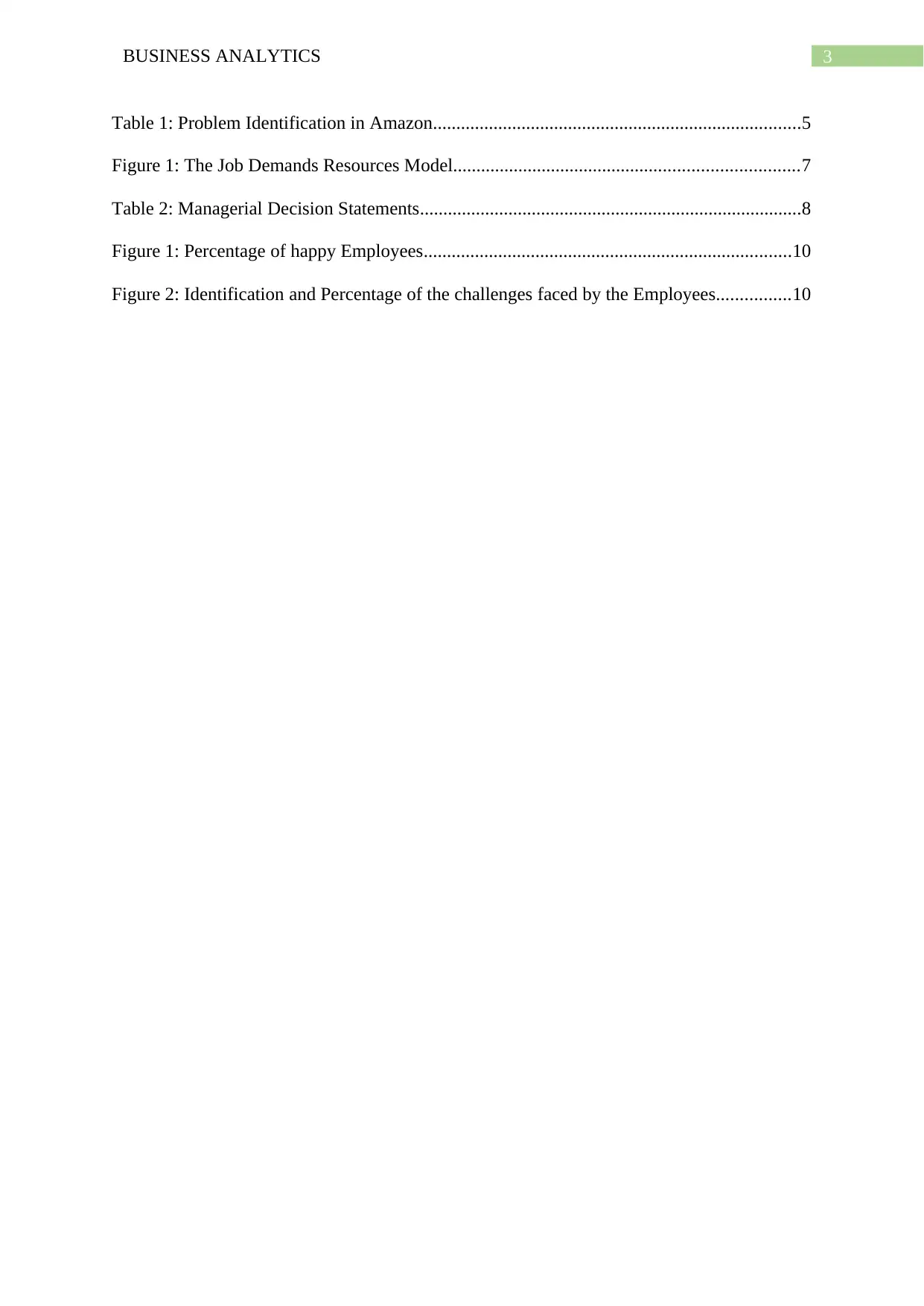
3BUSINESS ANALYTICS
Table 1: Problem Identification in Amazon...............................................................................5
Figure 1: The Job Demands Resources Model..........................................................................7
Table 2: Managerial Decision Statements..................................................................................8
Figure 1: Percentage of happy Employees...............................................................................10
Figure 2: Identification and Percentage of the challenges faced by the Employees................10
Table 1: Problem Identification in Amazon...............................................................................5
Figure 1: The Job Demands Resources Model..........................................................................7
Table 2: Managerial Decision Statements..................................................................................8
Figure 1: Percentage of happy Employees...............................................................................10
Figure 2: Identification and Percentage of the challenges faced by the Employees................10
⊘ This is a preview!⊘
Do you want full access?
Subscribe today to unlock all pages.

Trusted by 1+ million students worldwide
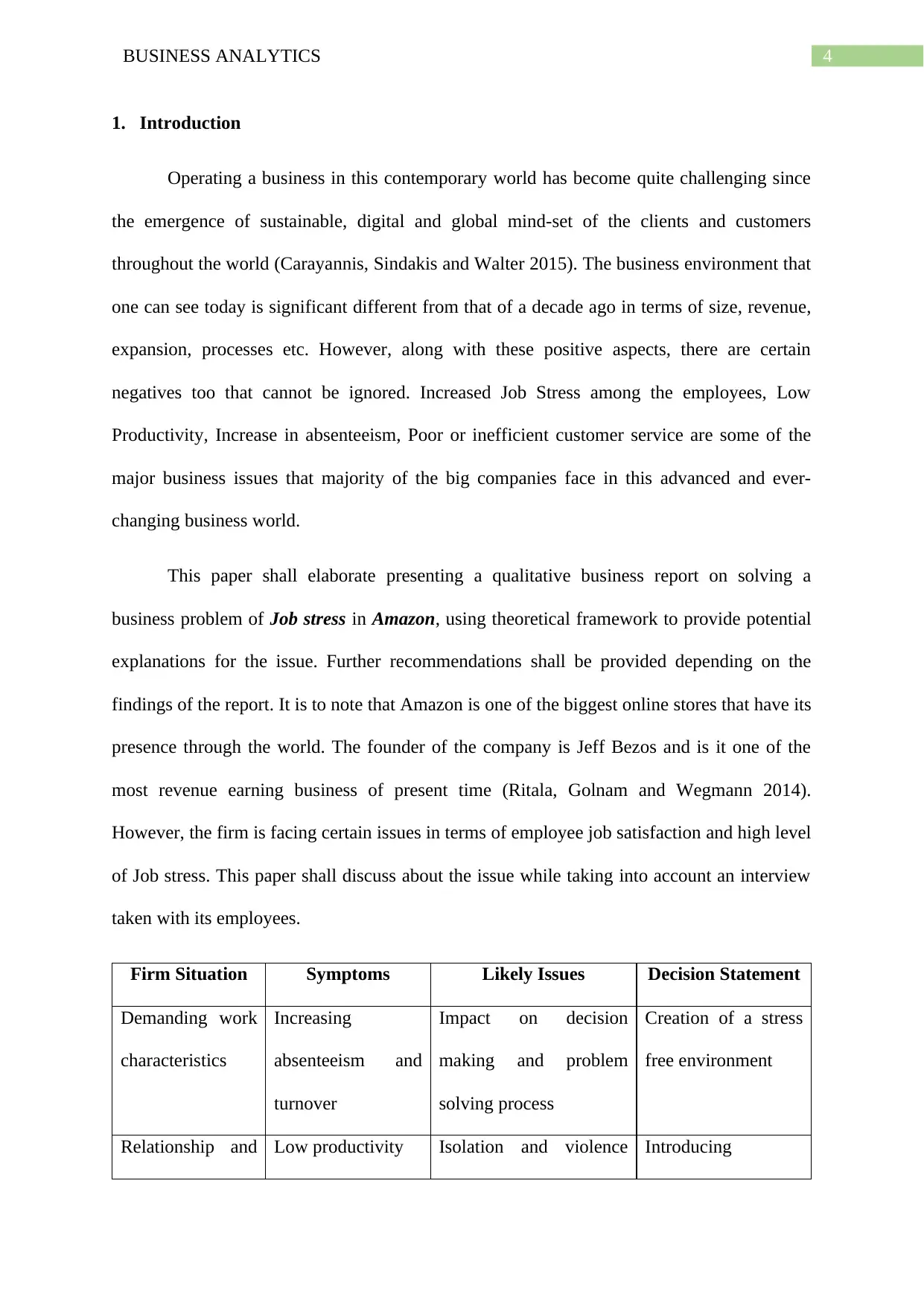
4BUSINESS ANALYTICS
1. Introduction
Operating a business in this contemporary world has become quite challenging since
the emergence of sustainable, digital and global mind-set of the clients and customers
throughout the world (Carayannis, Sindakis and Walter 2015). The business environment that
one can see today is significant different from that of a decade ago in terms of size, revenue,
expansion, processes etc. However, along with these positive aspects, there are certain
negatives too that cannot be ignored. Increased Job Stress among the employees, Low
Productivity, Increase in absenteeism, Poor or inefficient customer service are some of the
major business issues that majority of the big companies face in this advanced and ever-
changing business world.
This paper shall elaborate presenting a qualitative business report on solving a
business problem of Job stress in Amazon, using theoretical framework to provide potential
explanations for the issue. Further recommendations shall be provided depending on the
findings of the report. It is to note that Amazon is one of the biggest online stores that have its
presence through the world. The founder of the company is Jeff Bezos and is it one of the
most revenue earning business of present time (Ritala, Golnam and Wegmann 2014).
However, the firm is facing certain issues in terms of employee job satisfaction and high level
of Job stress. This paper shall discuss about the issue while taking into account an interview
taken with its employees.
Firm Situation Symptoms Likely Issues Decision Statement
Demanding work
characteristics
Increasing
absenteeism and
turnover
Impact on decision
making and problem
solving process
Creation of a stress
free environment
Relationship and Low productivity Isolation and violence Introducing
1. Introduction
Operating a business in this contemporary world has become quite challenging since
the emergence of sustainable, digital and global mind-set of the clients and customers
throughout the world (Carayannis, Sindakis and Walter 2015). The business environment that
one can see today is significant different from that of a decade ago in terms of size, revenue,
expansion, processes etc. However, along with these positive aspects, there are certain
negatives too that cannot be ignored. Increased Job Stress among the employees, Low
Productivity, Increase in absenteeism, Poor or inefficient customer service are some of the
major business issues that majority of the big companies face in this advanced and ever-
changing business world.
This paper shall elaborate presenting a qualitative business report on solving a
business problem of Job stress in Amazon, using theoretical framework to provide potential
explanations for the issue. Further recommendations shall be provided depending on the
findings of the report. It is to note that Amazon is one of the biggest online stores that have its
presence through the world. The founder of the company is Jeff Bezos and is it one of the
most revenue earning business of present time (Ritala, Golnam and Wegmann 2014).
However, the firm is facing certain issues in terms of employee job satisfaction and high level
of Job stress. This paper shall discuss about the issue while taking into account an interview
taken with its employees.
Firm Situation Symptoms Likely Issues Decision Statement
Demanding work
characteristics
Increasing
absenteeism and
turnover
Impact on decision
making and problem
solving process
Creation of a stress
free environment
Relationship and Low productivity Isolation and violence Introducing
Paraphrase This Document
Need a fresh take? Get an instant paraphrase of this document with our AI Paraphraser
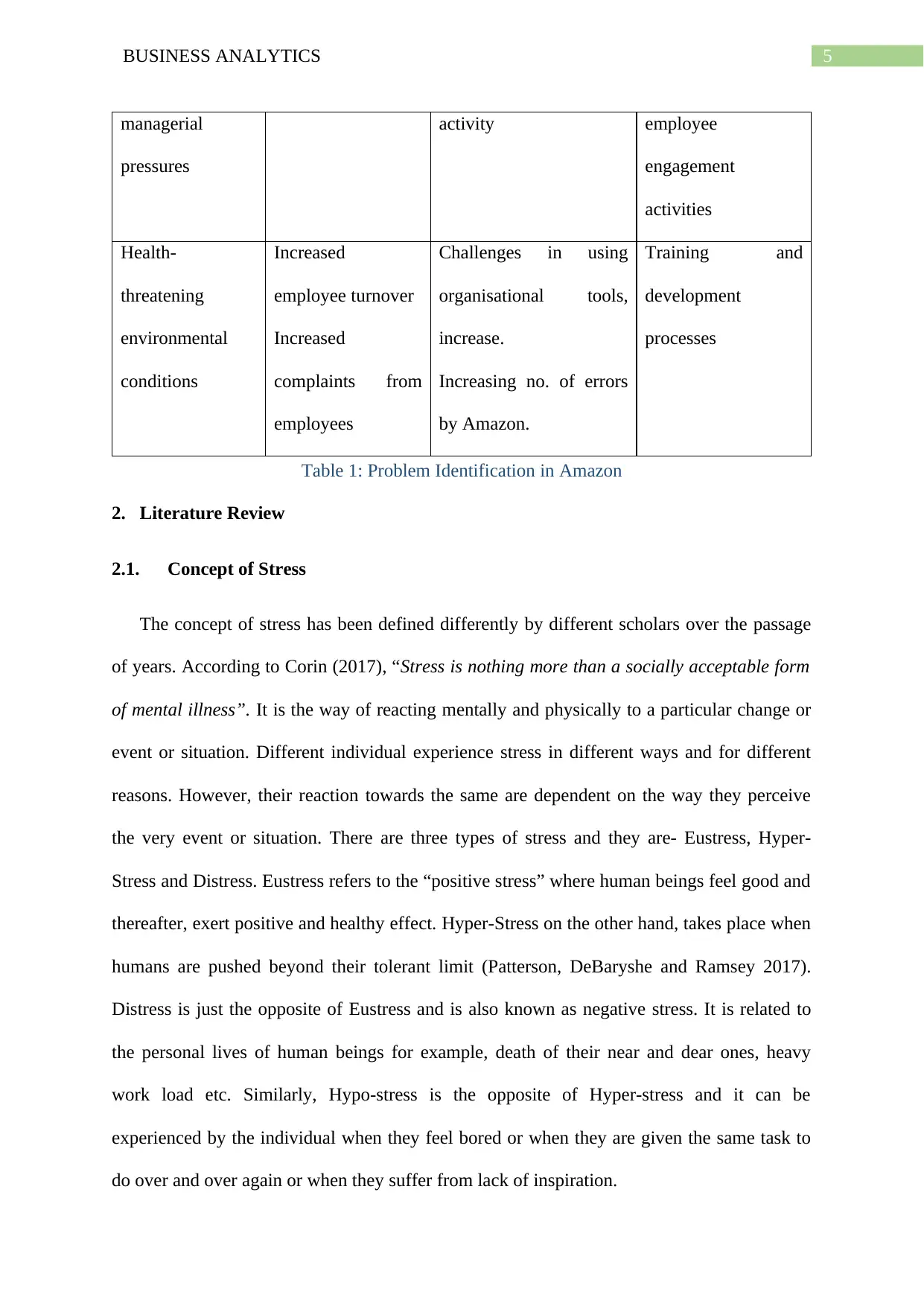
5BUSINESS ANALYTICS
managerial
pressures
activity employee
engagement
activities
Health-
threatening
environmental
conditions
Increased
employee turnover
Increased
complaints from
employees
Challenges in using
organisational tools,
increase.
Increasing no. of errors
by Amazon.
Training and
development
processes
Table 1: Problem Identification in Amazon
2. Literature Review
2.1. Concept of Stress
The concept of stress has been defined differently by different scholars over the passage
of years. According to Corin (2017), “Stress is nothing more than a socially acceptable form
of mental illness”. It is the way of reacting mentally and physically to a particular change or
event or situation. Different individual experience stress in different ways and for different
reasons. However, their reaction towards the same are dependent on the way they perceive
the very event or situation. There are three types of stress and they are- Eustress, Hyper-
Stress and Distress. Eustress refers to the “positive stress” where human beings feel good and
thereafter, exert positive and healthy effect. Hyper-Stress on the other hand, takes place when
humans are pushed beyond their tolerant limit (Patterson, DeBaryshe and Ramsey 2017).
Distress is just the opposite of Eustress and is also known as negative stress. It is related to
the personal lives of human beings for example, death of their near and dear ones, heavy
work load etc. Similarly, Hypo-stress is the opposite of Hyper-stress and it can be
experienced by the individual when they feel bored or when they are given the same task to
do over and over again or when they suffer from lack of inspiration.
managerial
pressures
activity employee
engagement
activities
Health-
threatening
environmental
conditions
Increased
employee turnover
Increased
complaints from
employees
Challenges in using
organisational tools,
increase.
Increasing no. of errors
by Amazon.
Training and
development
processes
Table 1: Problem Identification in Amazon
2. Literature Review
2.1. Concept of Stress
The concept of stress has been defined differently by different scholars over the passage
of years. According to Corin (2017), “Stress is nothing more than a socially acceptable form
of mental illness”. It is the way of reacting mentally and physically to a particular change or
event or situation. Different individual experience stress in different ways and for different
reasons. However, their reaction towards the same are dependent on the way they perceive
the very event or situation. There are three types of stress and they are- Eustress, Hyper-
Stress and Distress. Eustress refers to the “positive stress” where human beings feel good and
thereafter, exert positive and healthy effect. Hyper-Stress on the other hand, takes place when
humans are pushed beyond their tolerant limit (Patterson, DeBaryshe and Ramsey 2017).
Distress is just the opposite of Eustress and is also known as negative stress. It is related to
the personal lives of human beings for example, death of their near and dear ones, heavy
work load etc. Similarly, Hypo-stress is the opposite of Hyper-stress and it can be
experienced by the individual when they feel bored or when they are given the same task to
do over and over again or when they suffer from lack of inspiration.
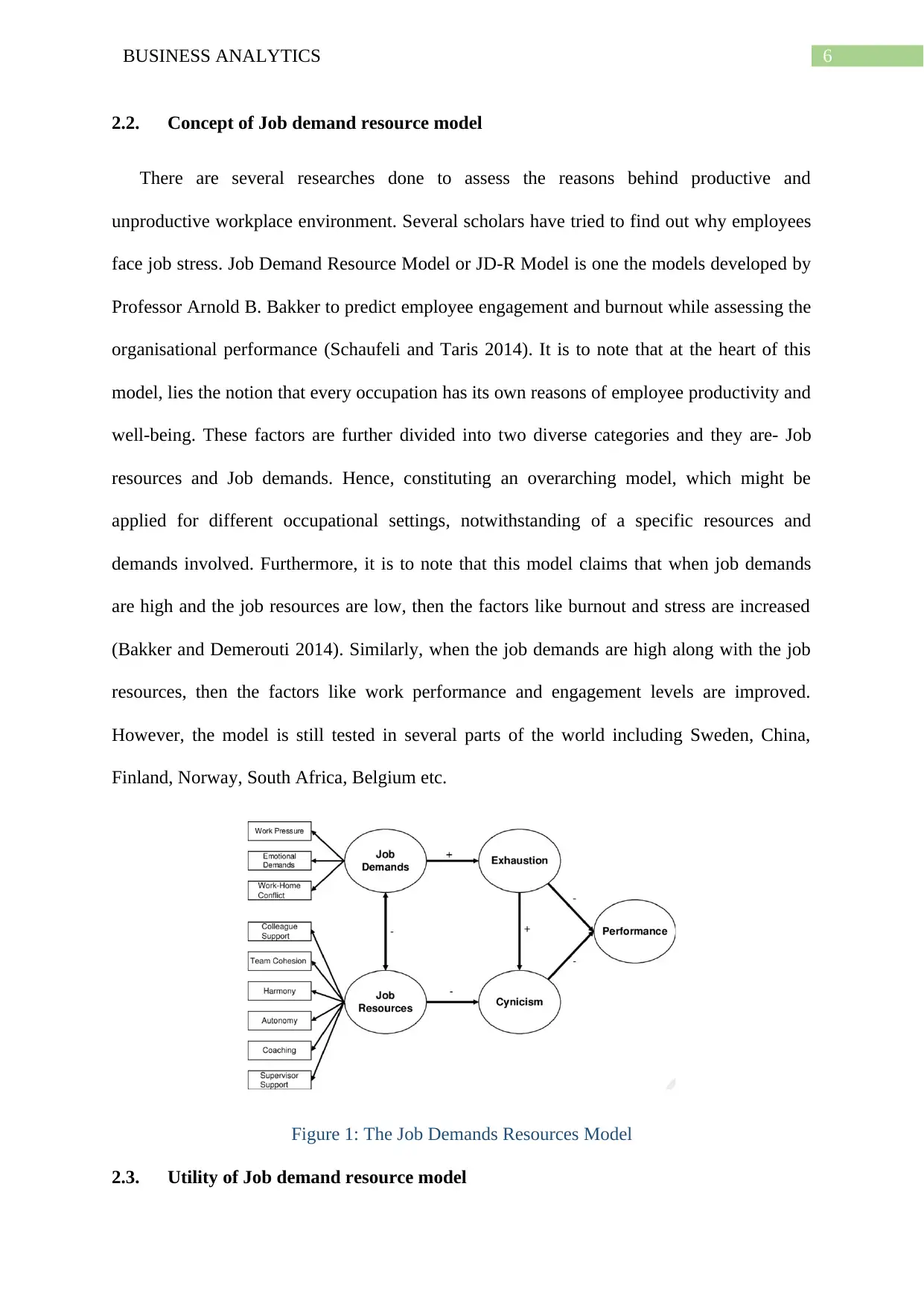
6BUSINESS ANALYTICS
2.2. Concept of Job demand resource model
There are several researches done to assess the reasons behind productive and
unproductive workplace environment. Several scholars have tried to find out why employees
face job stress. Job Demand Resource Model or JD-R Model is one the models developed by
Professor Arnold B. Bakker to predict employee engagement and burnout while assessing the
organisational performance (Schaufeli and Taris 2014). It is to note that at the heart of this
model, lies the notion that every occupation has its own reasons of employee productivity and
well-being. These factors are further divided into two diverse categories and they are- Job
resources and Job demands. Hence, constituting an overarching model, which might be
applied for different occupational settings, notwithstanding of a specific resources and
demands involved. Furthermore, it is to note that this model claims that when job demands
are high and the job resources are low, then the factors like burnout and stress are increased
(Bakker and Demerouti 2014). Similarly, when the job demands are high along with the job
resources, then the factors like work performance and engagement levels are improved.
However, the model is still tested in several parts of the world including Sweden, China,
Finland, Norway, South Africa, Belgium etc.
Figure 1: The Job Demands Resources Model
2.3. Utility of Job demand resource model
2.2. Concept of Job demand resource model
There are several researches done to assess the reasons behind productive and
unproductive workplace environment. Several scholars have tried to find out why employees
face job stress. Job Demand Resource Model or JD-R Model is one the models developed by
Professor Arnold B. Bakker to predict employee engagement and burnout while assessing the
organisational performance (Schaufeli and Taris 2014). It is to note that at the heart of this
model, lies the notion that every occupation has its own reasons of employee productivity and
well-being. These factors are further divided into two diverse categories and they are- Job
resources and Job demands. Hence, constituting an overarching model, which might be
applied for different occupational settings, notwithstanding of a specific resources and
demands involved. Furthermore, it is to note that this model claims that when job demands
are high and the job resources are low, then the factors like burnout and stress are increased
(Bakker and Demerouti 2014). Similarly, when the job demands are high along with the job
resources, then the factors like work performance and engagement levels are improved.
However, the model is still tested in several parts of the world including Sweden, China,
Finland, Norway, South Africa, Belgium etc.
Figure 1: The Job Demands Resources Model
2.3. Utility of Job demand resource model
⊘ This is a preview!⊘
Do you want full access?
Subscribe today to unlock all pages.

Trusted by 1+ million students worldwide
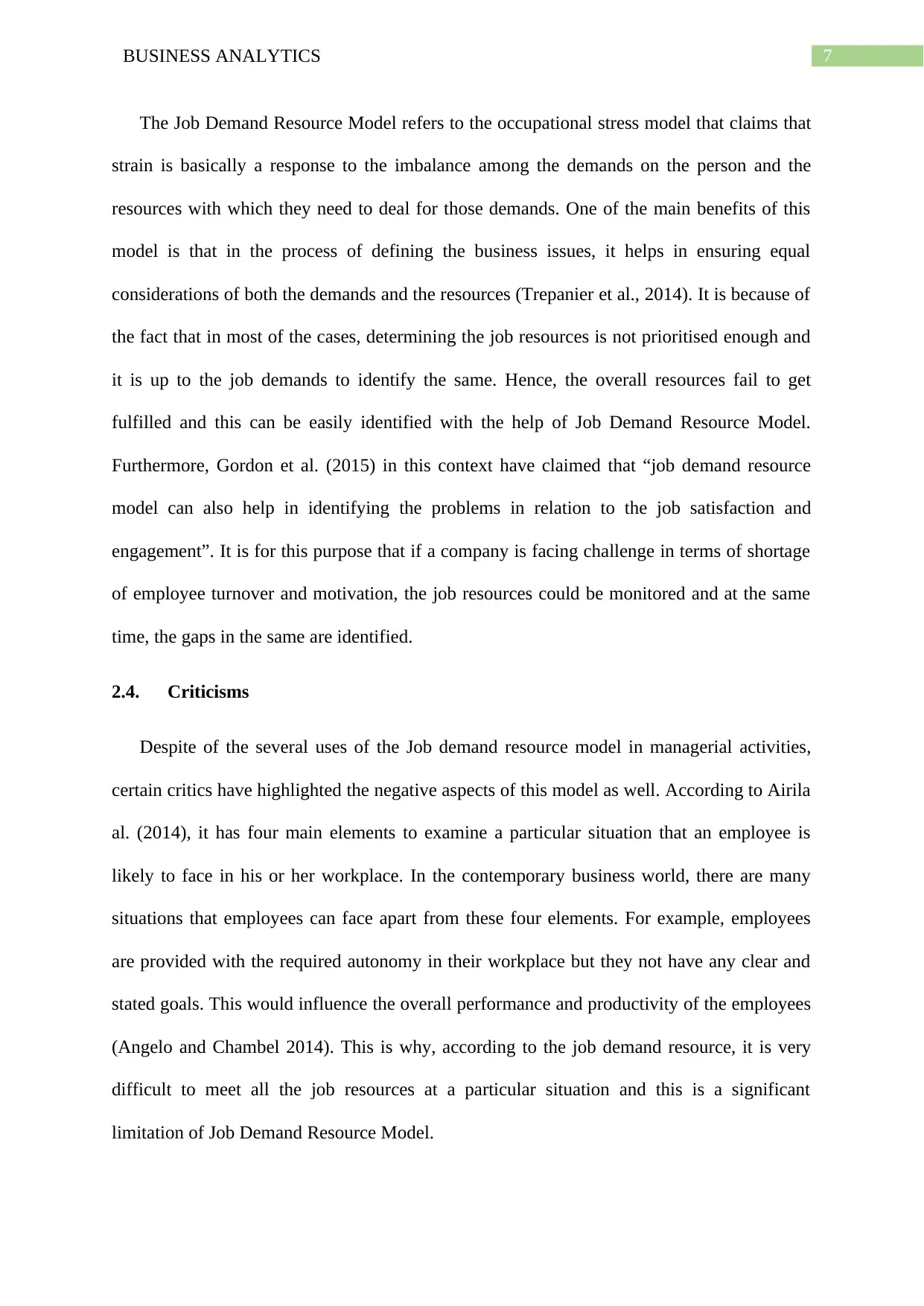
7BUSINESS ANALYTICS
The Job Demand Resource Model refers to the occupational stress model that claims that
strain is basically a response to the imbalance among the demands on the person and the
resources with which they need to deal for those demands. One of the main benefits of this
model is that in the process of defining the business issues, it helps in ensuring equal
considerations of both the demands and the resources (Trepanier et al., 2014). It is because of
the fact that in most of the cases, determining the job resources is not prioritised enough and
it is up to the job demands to identify the same. Hence, the overall resources fail to get
fulfilled and this can be easily identified with the help of Job Demand Resource Model.
Furthermore, Gordon et al. (2015) in this context have claimed that “job demand resource
model can also help in identifying the problems in relation to the job satisfaction and
engagement”. It is for this purpose that if a company is facing challenge in terms of shortage
of employee turnover and motivation, the job resources could be monitored and at the same
time, the gaps in the same are identified.
2.4. Criticisms
Despite of the several uses of the Job demand resource model in managerial activities,
certain critics have highlighted the negative aspects of this model as well. According to Airila
al. (2014), it has four main elements to examine a particular situation that an employee is
likely to face in his or her workplace. In the contemporary business world, there are many
situations that employees can face apart from these four elements. For example, employees
are provided with the required autonomy in their workplace but they not have any clear and
stated goals. This would influence the overall performance and productivity of the employees
(Angelo and Chambel 2014). This is why, according to the job demand resource, it is very
difficult to meet all the job resources at a particular situation and this is a significant
limitation of Job Demand Resource Model.
The Job Demand Resource Model refers to the occupational stress model that claims that
strain is basically a response to the imbalance among the demands on the person and the
resources with which they need to deal for those demands. One of the main benefits of this
model is that in the process of defining the business issues, it helps in ensuring equal
considerations of both the demands and the resources (Trepanier et al., 2014). It is because of
the fact that in most of the cases, determining the job resources is not prioritised enough and
it is up to the job demands to identify the same. Hence, the overall resources fail to get
fulfilled and this can be easily identified with the help of Job Demand Resource Model.
Furthermore, Gordon et al. (2015) in this context have claimed that “job demand resource
model can also help in identifying the problems in relation to the job satisfaction and
engagement”. It is for this purpose that if a company is facing challenge in terms of shortage
of employee turnover and motivation, the job resources could be monitored and at the same
time, the gaps in the same are identified.
2.4. Criticisms
Despite of the several uses of the Job demand resource model in managerial activities,
certain critics have highlighted the negative aspects of this model as well. According to Airila
al. (2014), it has four main elements to examine a particular situation that an employee is
likely to face in his or her workplace. In the contemporary business world, there are many
situations that employees can face apart from these four elements. For example, employees
are provided with the required autonomy in their workplace but they not have any clear and
stated goals. This would influence the overall performance and productivity of the employees
(Angelo and Chambel 2014). This is why, according to the job demand resource, it is very
difficult to meet all the job resources at a particular situation and this is a significant
limitation of Job Demand Resource Model.
Paraphrase This Document
Need a fresh take? Get an instant paraphrase of this document with our AI Paraphraser
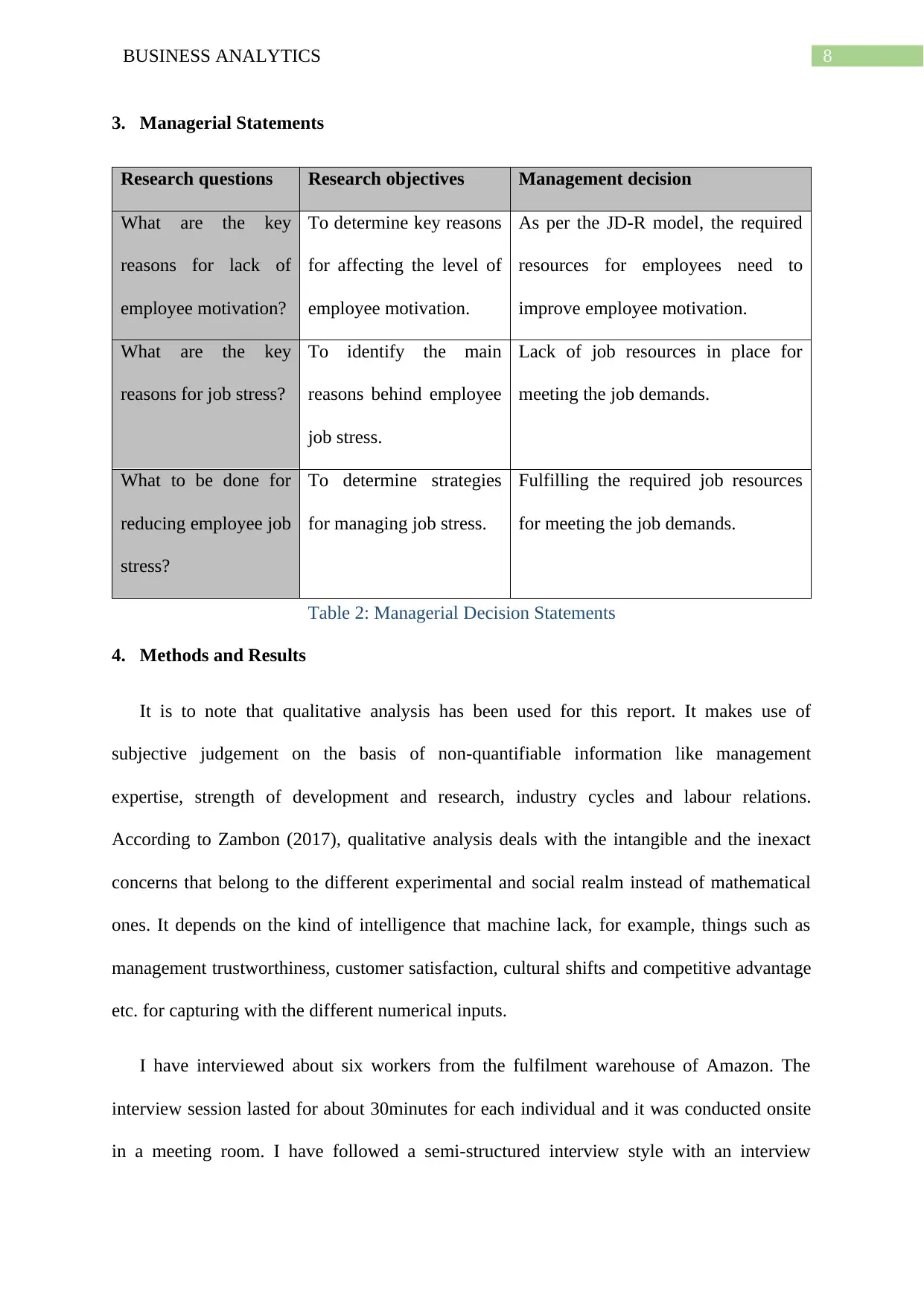
8BUSINESS ANALYTICS
3. Managerial Statements
Research questions Research objectives Management decision
What are the key
reasons for lack of
employee motivation?
To determine key reasons
for affecting the level of
employee motivation.
As per the JD-R model, the required
resources for employees need to
improve employee motivation.
What are the key
reasons for job stress?
To identify the main
reasons behind employee
job stress.
Lack of job resources in place for
meeting the job demands.
What to be done for
reducing employee job
stress?
To determine strategies
for managing job stress.
Fulfilling the required job resources
for meeting the job demands.
Table 2: Managerial Decision Statements
4. Methods and Results
It is to note that qualitative analysis has been used for this report. It makes use of
subjective judgement on the basis of non-quantifiable information like management
expertise, strength of development and research, industry cycles and labour relations.
According to Zambon (2017), qualitative analysis deals with the intangible and the inexact
concerns that belong to the different experimental and social realm instead of mathematical
ones. It depends on the kind of intelligence that machine lack, for example, things such as
management trustworthiness, customer satisfaction, cultural shifts and competitive advantage
etc. for capturing with the different numerical inputs.
I have interviewed about six workers from the fulfilment warehouse of Amazon. The
interview session lasted for about 30minutes for each individual and it was conducted onsite
in a meeting room. I have followed a semi-structured interview style with an interview
3. Managerial Statements
Research questions Research objectives Management decision
What are the key
reasons for lack of
employee motivation?
To determine key reasons
for affecting the level of
employee motivation.
As per the JD-R model, the required
resources for employees need to
improve employee motivation.
What are the key
reasons for job stress?
To identify the main
reasons behind employee
job stress.
Lack of job resources in place for
meeting the job demands.
What to be done for
reducing employee job
stress?
To determine strategies
for managing job stress.
Fulfilling the required job resources
for meeting the job demands.
Table 2: Managerial Decision Statements
4. Methods and Results
It is to note that qualitative analysis has been used for this report. It makes use of
subjective judgement on the basis of non-quantifiable information like management
expertise, strength of development and research, industry cycles and labour relations.
According to Zambon (2017), qualitative analysis deals with the intangible and the inexact
concerns that belong to the different experimental and social realm instead of mathematical
ones. It depends on the kind of intelligence that machine lack, for example, things such as
management trustworthiness, customer satisfaction, cultural shifts and competitive advantage
etc. for capturing with the different numerical inputs.
I have interviewed about six workers from the fulfilment warehouse of Amazon. The
interview session lasted for about 30minutes for each individual and it was conducted onsite
in a meeting room. I have followed a semi-structured interview style with an interview
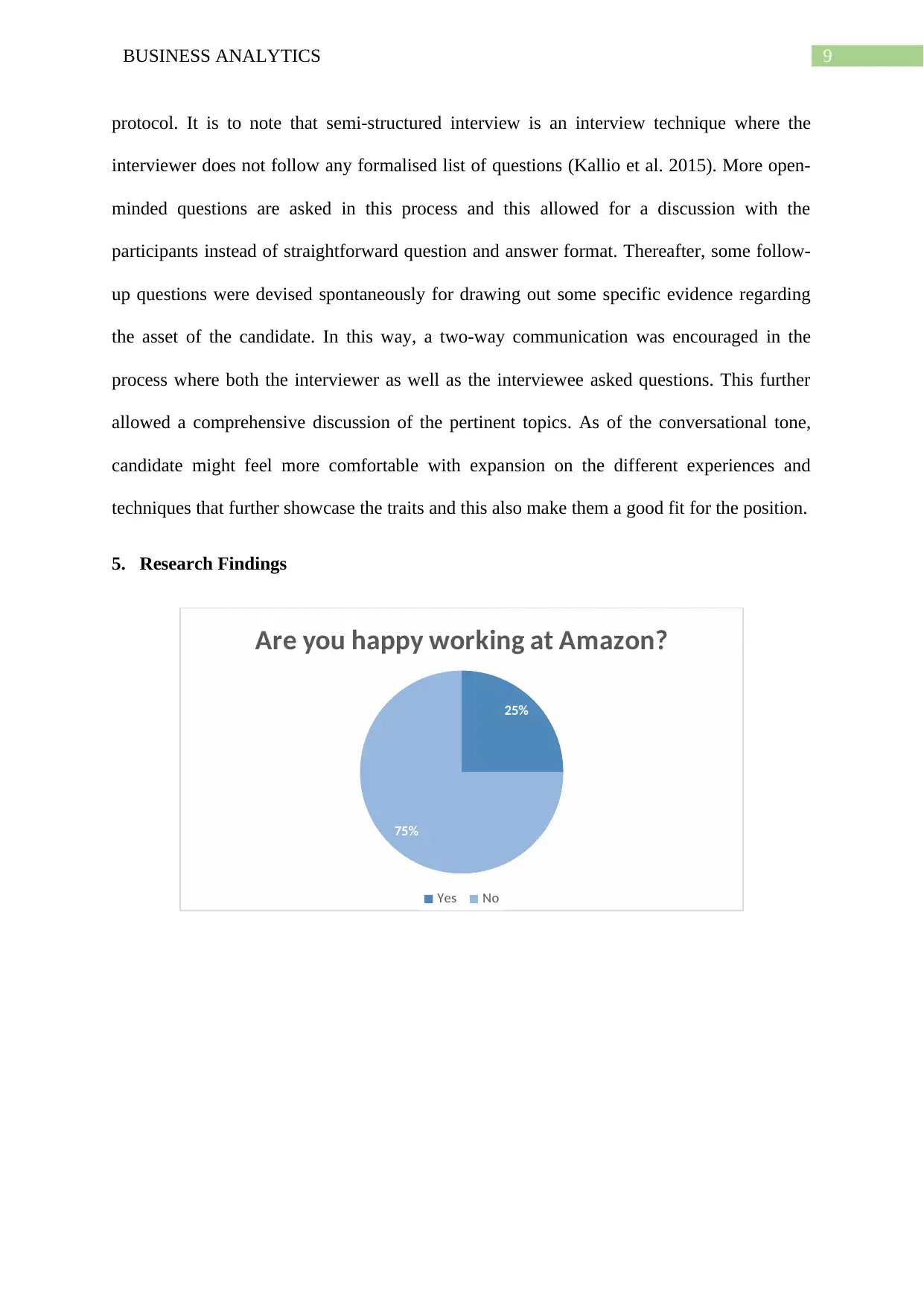
9BUSINESS ANALYTICS
protocol. It is to note that semi-structured interview is an interview technique where the
interviewer does not follow any formalised list of questions (Kallio et al. 2015). More open-
minded questions are asked in this process and this allowed for a discussion with the
participants instead of straightforward question and answer format. Thereafter, some follow-
up questions were devised spontaneously for drawing out some specific evidence regarding
the asset of the candidate. In this way, a two-way communication was encouraged in the
process where both the interviewer as well as the interviewee asked questions. This further
allowed a comprehensive discussion of the pertinent topics. As of the conversational tone,
candidate might feel more comfortable with expansion on the different experiences and
techniques that further showcase the traits and this also make them a good fit for the position.
5. Research Findings
25%
75%
Are you happy working at Amazon?
Yes No
protocol. It is to note that semi-structured interview is an interview technique where the
interviewer does not follow any formalised list of questions (Kallio et al. 2015). More open-
minded questions are asked in this process and this allowed for a discussion with the
participants instead of straightforward question and answer format. Thereafter, some follow-
up questions were devised spontaneously for drawing out some specific evidence regarding
the asset of the candidate. In this way, a two-way communication was encouraged in the
process where both the interviewer as well as the interviewee asked questions. This further
allowed a comprehensive discussion of the pertinent topics. As of the conversational tone,
candidate might feel more comfortable with expansion on the different experiences and
techniques that further showcase the traits and this also make them a good fit for the position.
5. Research Findings
25%
75%
Are you happy working at Amazon?
Yes No
⊘ This is a preview!⊘
Do you want full access?
Subscribe today to unlock all pages.

Trusted by 1+ million students worldwide
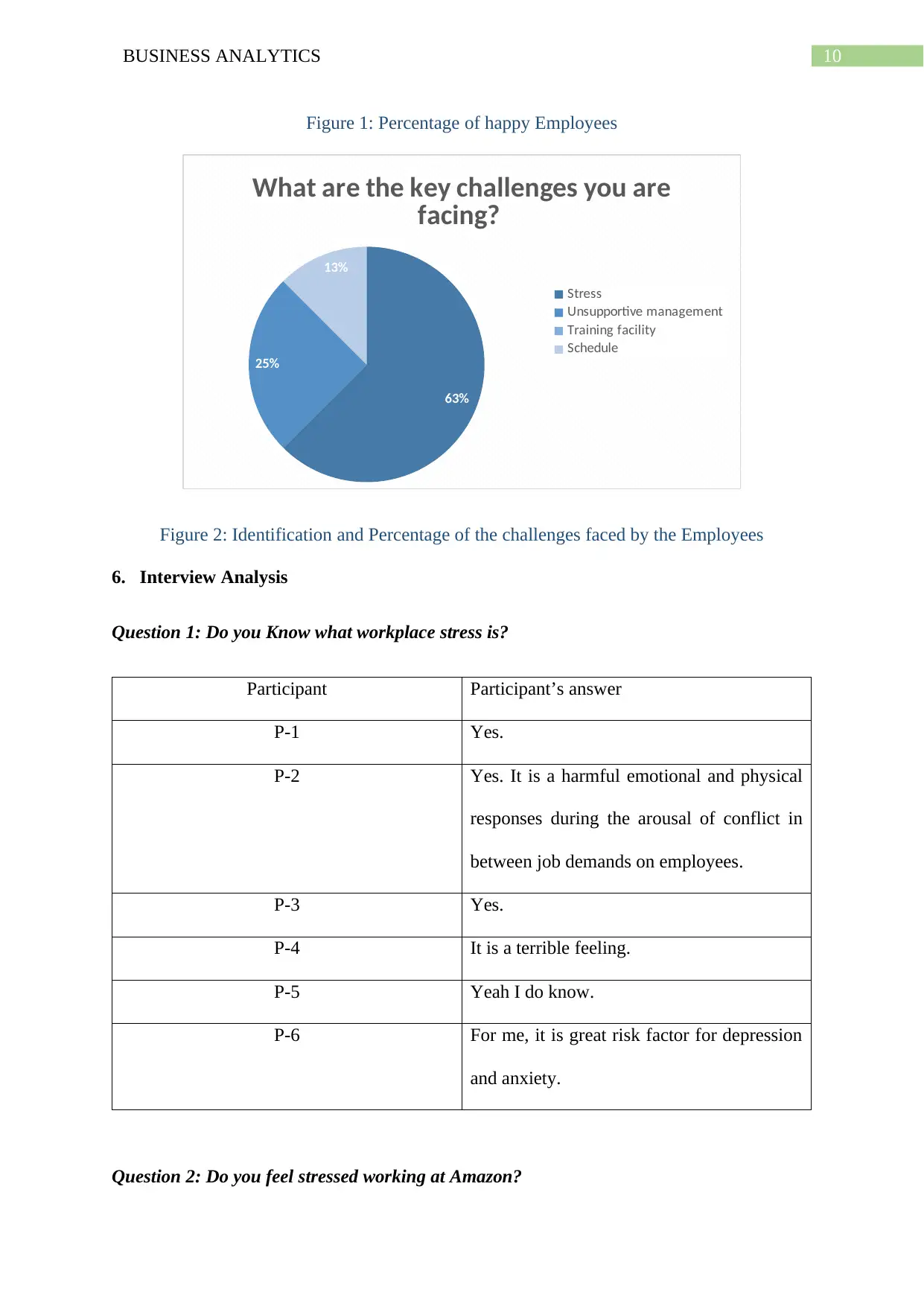
10BUSINESS ANALYTICS
Figure 1: Percentage of happy Employees
63%
25%
13%
What are the key challenges you are
facing?
Stress
Unsupportive management
Training facility
Schedule
Figure 2: Identification and Percentage of the challenges faced by the Employees
6. Interview Analysis
Question 1: Do you Know what workplace stress is?
Participant Participant’s answer
P-1 Yes.
P-2 Yes. It is a harmful emotional and physical
responses during the arousal of conflict in
between job demands on employees.
P-3 Yes.
P-4 It is a terrible feeling.
P-5 Yeah I do know.
P-6 For me, it is great risk factor for depression
and anxiety.
Question 2: Do you feel stressed working at Amazon?
Figure 1: Percentage of happy Employees
63%
25%
13%
What are the key challenges you are
facing?
Stress
Unsupportive management
Training facility
Schedule
Figure 2: Identification and Percentage of the challenges faced by the Employees
6. Interview Analysis
Question 1: Do you Know what workplace stress is?
Participant Participant’s answer
P-1 Yes.
P-2 Yes. It is a harmful emotional and physical
responses during the arousal of conflict in
between job demands on employees.
P-3 Yes.
P-4 It is a terrible feeling.
P-5 Yeah I do know.
P-6 For me, it is great risk factor for depression
and anxiety.
Question 2: Do you feel stressed working at Amazon?
Paraphrase This Document
Need a fresh take? Get an instant paraphrase of this document with our AI Paraphraser
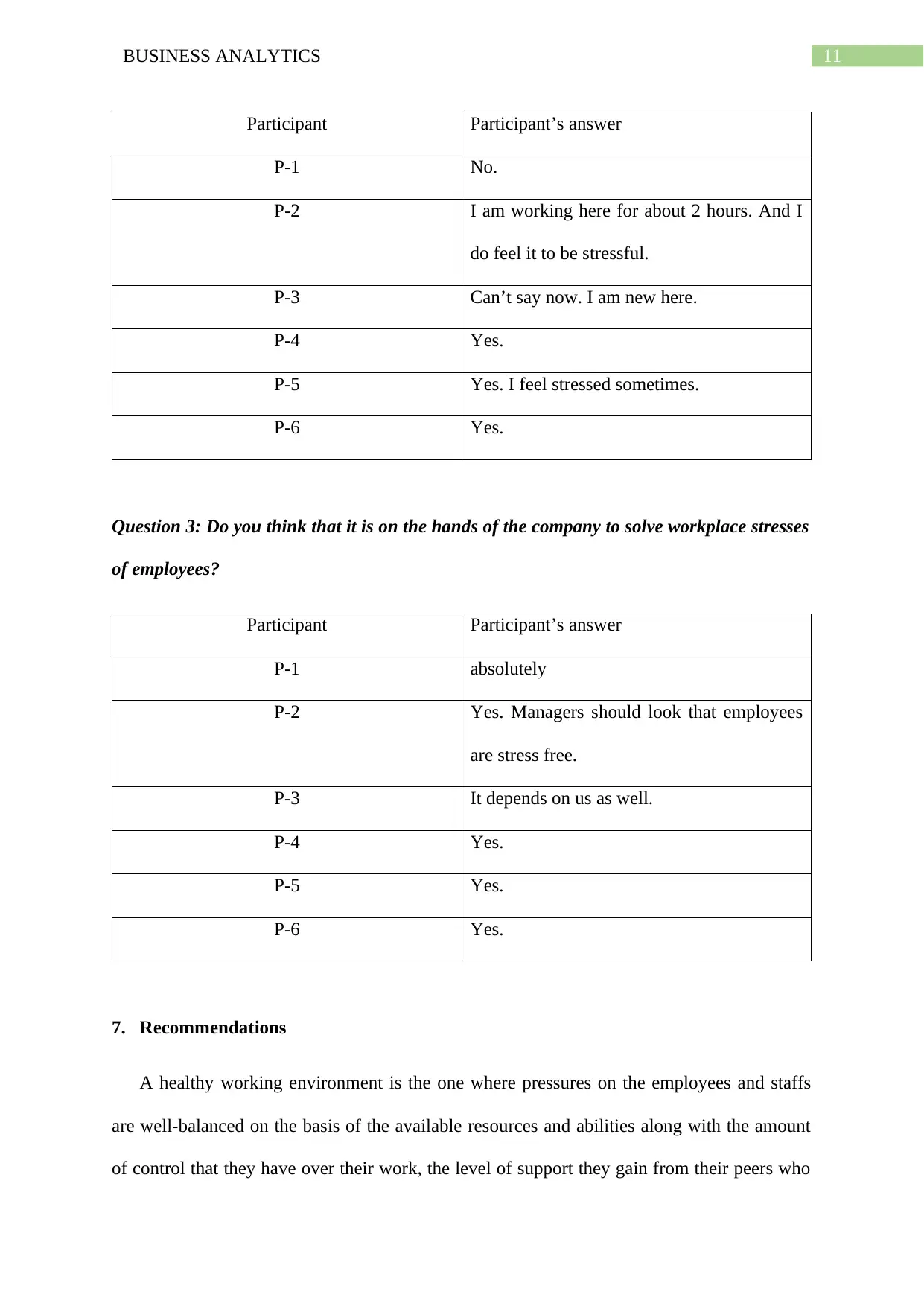
11BUSINESS ANALYTICS
Participant Participant’s answer
P-1 No.
P-2 I am working here for about 2 hours. And I
do feel it to be stressful.
P-3 Can’t say now. I am new here.
P-4 Yes.
P-5 Yes. I feel stressed sometimes.
P-6 Yes.
Question 3: Do you think that it is on the hands of the company to solve workplace stresses
of employees?
Participant Participant’s answer
P-1 absolutely
P-2 Yes. Managers should look that employees
are stress free.
P-3 It depends on us as well.
P-4 Yes.
P-5 Yes.
P-6 Yes.
7. Recommendations
A healthy working environment is the one where pressures on the employees and staffs
are well-balanced on the basis of the available resources and abilities along with the amount
of control that they have over their work, the level of support they gain from their peers who
Participant Participant’s answer
P-1 No.
P-2 I am working here for about 2 hours. And I
do feel it to be stressful.
P-3 Can’t say now. I am new here.
P-4 Yes.
P-5 Yes. I feel stressed sometimes.
P-6 Yes.
Question 3: Do you think that it is on the hands of the company to solve workplace stresses
of employees?
Participant Participant’s answer
P-1 absolutely
P-2 Yes. Managers should look that employees
are stress free.
P-3 It depends on us as well.
P-4 Yes.
P-5 Yes.
P-6 Yes.
7. Recommendations
A healthy working environment is the one where pressures on the employees and staffs
are well-balanced on the basis of the available resources and abilities along with the amount
of control that they have over their work, the level of support they gain from their peers who
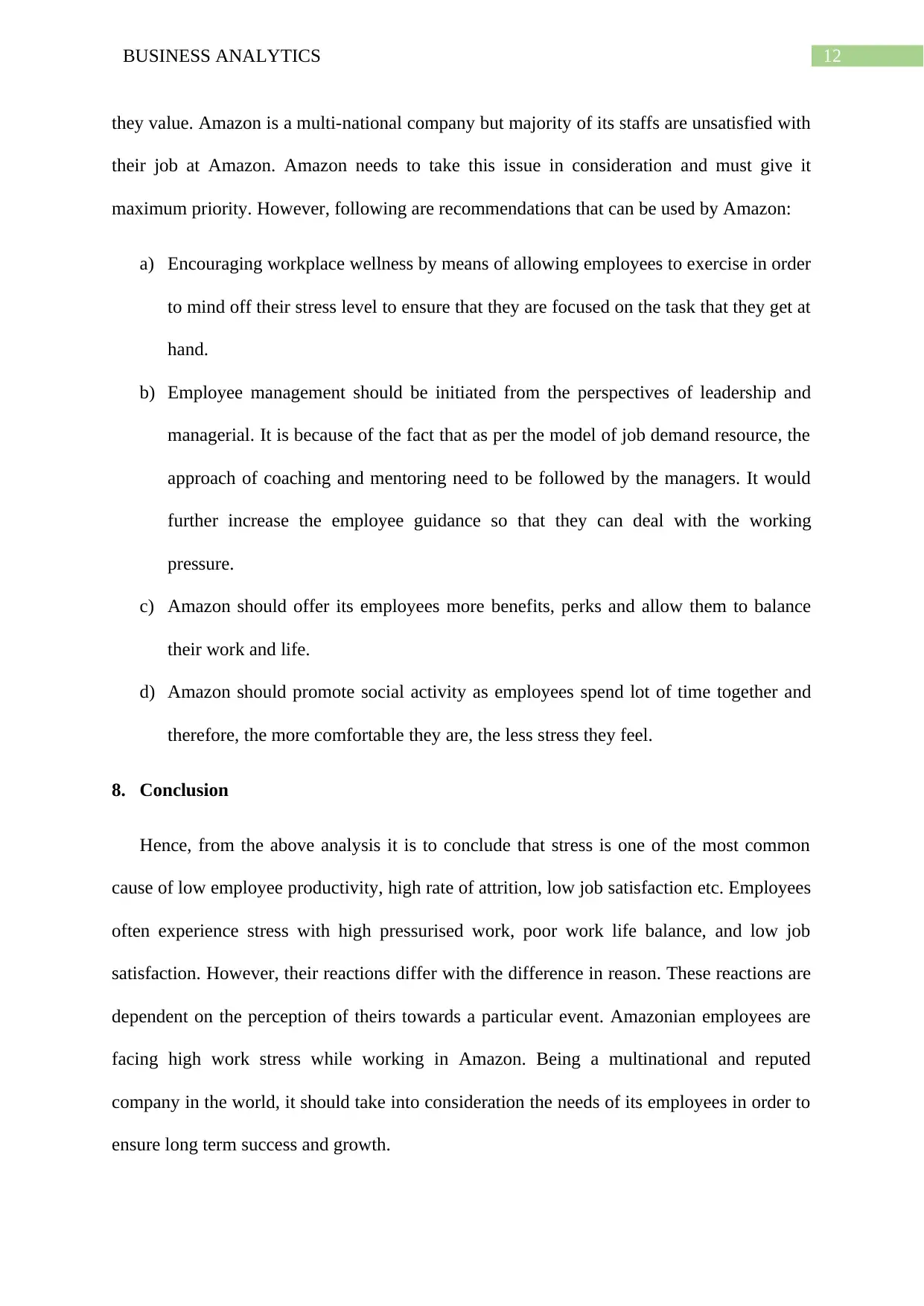
12BUSINESS ANALYTICS
they value. Amazon is a multi-national company but majority of its staffs are unsatisfied with
their job at Amazon. Amazon needs to take this issue in consideration and must give it
maximum priority. However, following are recommendations that can be used by Amazon:
a) Encouraging workplace wellness by means of allowing employees to exercise in order
to mind off their stress level to ensure that they are focused on the task that they get at
hand.
b) Employee management should be initiated from the perspectives of leadership and
managerial. It is because of the fact that as per the model of job demand resource, the
approach of coaching and mentoring need to be followed by the managers. It would
further increase the employee guidance so that they can deal with the working
pressure.
c) Amazon should offer its employees more benefits, perks and allow them to balance
their work and life.
d) Amazon should promote social activity as employees spend lot of time together and
therefore, the more comfortable they are, the less stress they feel.
8. Conclusion
Hence, from the above analysis it is to conclude that stress is one of the most common
cause of low employee productivity, high rate of attrition, low job satisfaction etc. Employees
often experience stress with high pressurised work, poor work life balance, and low job
satisfaction. However, their reactions differ with the difference in reason. These reactions are
dependent on the perception of theirs towards a particular event. Amazonian employees are
facing high work stress while working in Amazon. Being a multinational and reputed
company in the world, it should take into consideration the needs of its employees in order to
ensure long term success and growth.
they value. Amazon is a multi-national company but majority of its staffs are unsatisfied with
their job at Amazon. Amazon needs to take this issue in consideration and must give it
maximum priority. However, following are recommendations that can be used by Amazon:
a) Encouraging workplace wellness by means of allowing employees to exercise in order
to mind off their stress level to ensure that they are focused on the task that they get at
hand.
b) Employee management should be initiated from the perspectives of leadership and
managerial. It is because of the fact that as per the model of job demand resource, the
approach of coaching and mentoring need to be followed by the managers. It would
further increase the employee guidance so that they can deal with the working
pressure.
c) Amazon should offer its employees more benefits, perks and allow them to balance
their work and life.
d) Amazon should promote social activity as employees spend lot of time together and
therefore, the more comfortable they are, the less stress they feel.
8. Conclusion
Hence, from the above analysis it is to conclude that stress is one of the most common
cause of low employee productivity, high rate of attrition, low job satisfaction etc. Employees
often experience stress with high pressurised work, poor work life balance, and low job
satisfaction. However, their reactions differ with the difference in reason. These reactions are
dependent on the perception of theirs towards a particular event. Amazonian employees are
facing high work stress while working in Amazon. Being a multinational and reputed
company in the world, it should take into consideration the needs of its employees in order to
ensure long term success and growth.
⊘ This is a preview!⊘
Do you want full access?
Subscribe today to unlock all pages.

Trusted by 1+ million students worldwide
1 out of 14
Related Documents
Your All-in-One AI-Powered Toolkit for Academic Success.
+13062052269
info@desklib.com
Available 24*7 on WhatsApp / Email
![[object Object]](/_next/static/media/star-bottom.7253800d.svg)
Unlock your academic potential
Copyright © 2020–2025 A2Z Services. All Rights Reserved. Developed and managed by ZUCOL.





